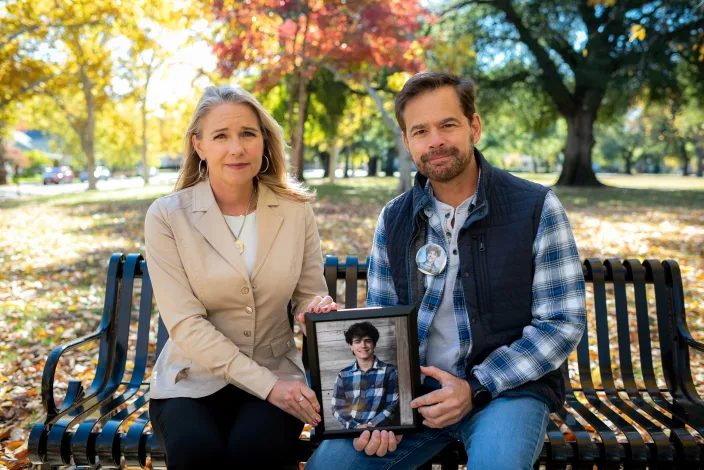
“As I got within two feet of him, I didn’t feel what I would normally feel,” he said. “When you approach a dead body, there is a void there, and I’d never sensed that before, and that’s when my world was destroyed.”
Pulling Zach out of the chair, Chris began performing CPR, screaming for his other son to call 911.
Once paramedics arrived at their home in Rocklin, Calif., they told the frantic father it was too late to save Zach, a high school senior who had no history of using drugs. Chris, an Air Force veteran who now works as an airline pilot, refused to accept it.
“I got angry and fought them and I said, ‘No, failure is not an option, we cannot stop,’ ” he recalled. “Help me save my son!” he screamed.
Chris tried unsuccessfully to grab the defibrillator from the responders. When someone finally pulled him off Zach’s body, he howled and curled up in a fetal position.
First responders convinced the family to wait in the front yard while they examined Zach’s bedroom for clues to what might have happened. Standing outside, Zach’s mother, Laura Didier, heard someone say that her son’s death might have been caused by fentanyl.
“I was like, what is that? How would my kid get it? I don’t understand what you’re telling me right now,” said Laura.
Two days before his death, Zach had celebrated Christmas with his family. He was a 17-year-old Eagle Scout, a soccer player and the star of his school musical. He liked to challenge his father to push-up contests.
On Dec. 27, 2020, he became one of the last of nearly 93,655 Americans to die that year of a drug overdose – a record wave fueled partly by what officials say is a scourge of fake prescription pills that contain fentanyl, a powerful chemical opioid that kills by overpowering the body’s natural instinct to breathe.
2021 set a new record of 107,622 overdose deaths – more than double the number from 2015, and 20 times the annual toll during the crack cocaine era of the late 1980s. Alarmed drug enforcement officials ramped up their warnings that “One Pill Can Kill,” a campaign to alert the public that the illicit drug market, boosted by easy access to online dealers, was flooded with pills that seemed harmless but were often deadly.
Historically, drug overdoses in America traced a sad path from recreational drug use to addiction to death. While that still happens, an alarming number of fentanyl deaths are now caused by what officials call “hot” pills – tablets made to look like prescription medicine but which instead contain potentially lethal amounts of fentanyl.
In many cases the pills are purchased on social media sites like Facebook or Snapchat.
“These aren’t real medicines that people are buying. Many people don’t know they are taking fentanyl, and they die,” said Anne Milgram, head of the Drug Enforcement Administration.
After Zach’s death, his bewildered parents tried to understand it. The local police department searched the house, but in the first days after his death, investigators didn’t think of it as a criminal matter.
No drugs or drug paraphernalia were found in his room. Nothing about his life indicated he had any interest in drugs, let alone that he was using them. Over time, however, Zach’s grieving classmates offered small clues.
A soccer teammate recalled Zach saying something about taking a Percocet pill – a prescription painkiller that contains oxycodone and acetaminophen and is often prescribed for moderate pain, such as after dental surgery.
After relaying that information to the local prosecutor’s office, the family was visited by an undercover drug investigator.
“He showed up wearing a Budweiser shirt, with a nametag that said ‘Hank’, and a long beard like the guys in ZZ Top,” said Chris, who insisted on being shown a police badge.
It took the investigator less than 90 seconds to find the drug dealer on Zach’s phone. He showed Chris the dealer’s online profile, which featured a video of a table covered with bags of pills and drug paraphernalia.
“Oh look at that, he just messaged Zach,” the investigator said, according to Chris. “We have a live fish, and we’re going to need to take this phone.”
From there, investigators were able to piece together the lethal transaction, which was arranged on Snapchat. The dealer, Virgil Bordner, had sold Zach two, maybe three pills that were supposed to be Percocet. The one that killed him was likely the second one he took.
Weeks later, the toxicology results confirmed it: Zach had died of a fentanyl overdose. The tests found no trace of Percocet in his system, his parents said.
“When people hear the words fentanyl and overdose, what they understand is the old war on drugs, and people suffering from addiction,” said his father. “And not to take away from those who struggle with substance abuse, but the new demographic is people who unwittingly consume fentanyl thinking they are taking a harmless product, and they don’t really understand they are taking a huge risk.”
Snapchat and other social media sites have become “the superhighway of drugs,” said Milgram, the DEA head. “We see this all the time – people will be in a chat about something they care about, a concert or something, and dealers will come in and try to connect with these people.”
Milgram said social media sites don’t do enough to enforce their own terms of service, which bar drug dealing, even though they have access to data that should reveal that activity.
“Their entire model is based on leveraging user data. So they know what is happening,” she said. “They control their engineering, they control their artificial intelligence, they are driving people through algorithms to different pages on their platform.”
At the same time, Milgram said, dealers who operate on Snapchat have an easier time hiding evidence from law enforcement, thanks to a feature that erases a conversation after 24 hours.
“This is all happening in a way that they’re not stopping it,” Milgram said. “They’re stopping us from being able to do what we could to save lives.”
Jennifer Stout, a vice president at Snap, Inc., called the company’s efforts to combat fentanyl sales “unwavering.”
“We deploy advanced technology to proactively detect and remove drug dealers from our platform, and work with experts to educate our community about the dangers of counterfeit pills laced with fentanyl,” she said in a statement. “Ending fentanyl deaths will require a sustained effort and partnership across industry, government, and the nonprofit sector, and we will continue to do everything we can to tackle this national crisis.”
When the company finds a drug dealer using Snapchat, they remove them from the platform and take steps to try to prevent them from getting back on it, the company said. Snapchat also assists law enforcement in drug investigations, as it did in the Didier case, the company said.
Placer County District Attorney Morgan Gire, who handled the Didier case, said he appreciated Snapchat’s efforts to aid investigators, but he also saw that as their obligation.
“The least they can do is help us use that platform to help us investigate and prosecute those same dealers,” Gire said. “Snapchat is getting there, but it can be somewhat shocking how uncomplicated the coding is for dealers to sell and advertise their products on social media.”
Between May and September of this year, the DEA conducted 390 drug-poisoning investigations. Of those, 129 had direct ties to social media. Many dealers hop across different platforms with customers to complete a sale, officials said, making it more difficult for investigators to retrace their steps.
“Think about Zach Didier ordering two Percocet off Snapchat, believing it was real drugs when it was not, it was fentanyl and filler,” Milgram said.
In September, Bordner, the dealer who sold the pills to Zach, was sentenced to 17 years in prison after pleading no contest to involuntary manslaughter and selling fentanyl.
Zach’s parents, who have become drug-awareness advocates, used the sentencing as another chance to warn parents to talk to their kids about fake pills.
“I just want his life to make a difference,” Laura said. “He deserved that.”
They stayed in their house for more than a year after Zach’s death, determined to go through all the “firsts” of the calendar in the house where their son grew up, and where he died.
“His room stayed exactly the same for 15 months,” said Laura. “Sometimes it was very hard for me to go in there – to see his desk. You can still see where his spirit left.”
Chris thinks of his son’s death as a warning. The greatest danger America faces, he said, is far closer to home – and more mundane – than many realize.
“Our country kicked off a 20-year global war on terror, and much of that fight was in Iraq and Afghanistan. It was dangerous, it was lethal, and I know, because I was there and I lost a lot of friends. We had a death rate of almost one American life lost every single day,” he said. “But fentanyl has a death rate about 200 times worse. How is this not a bigger priority in our country, in our government?”
